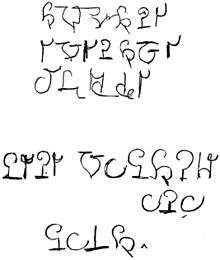Automatic writing
| Part of a series on |
| Spiritualism |
|---|
| Practices |
| Related topics |
Automatic writing or psychography is an alleged psychic ability allowing a person to produce written words without consciously writing. The words are claimed to arise from a subconscious, spiritual or supernatural source.[1]
History
Automatic writing as a spiritual practice was reported by Hyppolyte Taine in the preface to the third edition of his "De l'intelligence", published in 1878. Besides "etherial visions" or "magnetic auras", Fernando Pessoa claimed to have experienced automatic writing. He said he felt "owned by something else", sometimes feeling a sensation in the right arm which he claimed was lifted into the air without his will.[2] George Hyde-Lees, the wife of William Butler Yeats, also claimed that she could write automatically.[3]

William Fletcher Barrett wrote that "Automatic messages may take place either by the writer passively holding a pencil on a sheet of paper, or by the planchette, or by a 'ouija board'."[4] In spiritualism, spirits are claimed to take control of the hand of a medium to write messages, letters, and even entire books. Automatic writing can happen in a trance or waking state.[5] Arthur Conan Doyle in his book The New Revelation (1918) wrote that automatic writing occurs either by the writer's subconscious or by external spirits operating through the writer.[6] The Surrealist poet Robert Desnos claimed he was among the most gifted in automatic writing. Some psychical researchers such as Thomson Jay Hudson have claimed that no spirits are involved in automatic writing and that the subconscious mind is the explanation.[7]
Alleged cases of automatic writing have included Jane Roberts,[8] Helen Schucman [9] and Neale Donald Walsch.[10][11] In 1975, Wendy Hart of Maidenhead claimed that she wrote automatically about Nicholas Moore, a sea captain who died in 1642.[12]
Scientific analysis
Scientists and skeptics consider automatic writing to be the result of the ideomotor effect.[13][14][15][16]
The physician Charles Arthur Mercier in the British Medical Journal (1894) criticized the spiritualist interpretation of automatic writing concluding "there is no need nor room for the agency of spirits, and the invocation of such agency is the sign of a mind not merely unscientific, but uninformed."[17] According to skeptical investigator Joe Nickell "automatic writing is produced while one is in a dissociated state. It is a form of motor automatism, or unconscious muscular activity."[18]
Psychology professor Théodore Flournoy investigated the claim by 19th-century medium Hélène Smith (Catherine Müller) that she did automatic writing to convey messages from Mars in Martian language. Flournoy concluded that her "Martian" language had a strong resemblance to Ms. Smith's native language of French and that her automatic writing was "romances of the subliminal imagination, derived largely from forgotten sources (for example, books read as a child)." He invented the term cryptomnesia to describe this phenomenon.[19]
Automatic writing behavior was discovered in three patients with right hemispheric damage.[20]
See also
| Wikisource has the text of the 1911 Encyclopædia Britannica article Automatic Writing. |
- Automatic drawing
- Artistic inspiration
- Asemic writing
- Automatic speech
- Hypergraphia
- Joseph Sieber Benner
- Matthew Manning
- Ouija
- Surrealist automatism
- List of topics characterized as pseudoscience
Footnotes
- ↑ Spence, Lewis. (2003). An Encyclopaedia of Occultism. Dover Edition. p. 56. ISBN 0-486-42613-0
- ↑ Pessoa, Fernando (1999), Correspondência 1905-1922, Assírio & Alvim, pp. 214–219, ISBN 978-85-7164-916-3.
- ↑ Marjorie Elizabeth Howes, John S. Kelly The Cambridge Companion to W.B. Yeats 2006, p. 11
- ↑ William Fletcher Barrett On the Threshold of the Unseen Cambridge University Press, 2011, p. 162
- ↑ Dictionary Definition
- ↑ Arthur Conan Doyle The New Revelation 2010 Reprint Edition, p. 47
- ↑ Thomson Jay Hudson The Law of Psychic Phenomena Wildhern Press, 2009, p. 252
- ↑ Seth Speaks
- ↑ A Course in Miracles (1975)
- ↑ Conversations with God (1996)
- ↑ Sue Lim Good Spirits, Bad Spirits: How to Distinguish Between Them 2002, p. 82
- ↑ Ivan Rabey's Book of St Columb (1979)
- ↑ Burgess, C.A., Kirsch, I., Shane, H., Niederauer, K.L., Graham, S.M., & Bacon, A. (1998). Facilitated Communication as an Ideomotor Response. Psychological Science 9: 71-74.
- ↑ Heap, Michael. (2002). Ideomotor Effect (the Ouija Board Effect). In Michael Shermer. The Skeptic Encyclopedia of Pseudoscience. ABC-CLIO. pp. 127-129. ISBN 1-57607-654-7
- ↑ Erickson, Milton H; Hershman, Seymour: Secter, Irving I. (2014). The Practical Application of Medical and Dental Hypnosis. Routledge. pp. 68-69. ISBN 0-87630-570-2
- ↑ Stollznow, Karen. (2014). Language Myths, Mysteries and Magic. Palgrave Macmillan. p. 114. ISBN 978-1-137-40484-8
- ↑ Mercier, Charles Arthur. (1894). "Automatic Writing". British Medical Journal. 1 (1726): 198-199.
- ↑ Nickell, Joe. (2007). "A Case of Automatic Writing From Robert G. Ingersoll’s Spirit?". Csicop.org. Retrieved 2014-10-11.
- ↑ Randi, James. (1995). An Encyclopedia of Claims, Frauds, and Hoaxes of the Occult and Supernatural. St. Martin's Press. p. 22. ISBN 0-312-15119-5
- ↑ Evyapan, Dilek; Kumral, Emre, (2001). Visuospatial Stimulus-Bound Automatic Writing Behavior: A Right Hemispheric Stroke Syndrome. Neurology 56: 245-247.
Further reading
- Carpenter, William Benjamin (March 12, 1852). "On the influence of Suggestion in Modifying and directing Muscular Movement, independently of Volition". Retrieved 2011-03-02.
- Joseph, A. B. (1986). A Hypergraphic Syndrome of Automatic Writing, Affective Disorder, and Temporal Lobe Epilepsy in Two Patients. Journal of Clinical Psychiatry 47: 255-257.
- Walsh, E., Mehta, M. A., Oakley, D. A., Guilmette, D. N., Gabay, A., Halligan, Peter and Deeley, Q. (2014). Using Suggestion to Model Different Types of Automatic Writing. Consciousness and Cognition 26: 24-36.
- Zusne, Leonard; Jones, Warren H. (2014). Anomalistic Psychology: A Study of Magical Thinking. Psychology Press. ISBN 978-0-805-80508-6
External links
- Carroll, Robert Todd. "Automatic writing". The Skeptic's Dictionary. 2003. ISBN 0-471-27242-6.
- Randi, James. "Automatic writing". An Encyclopedia of Claims, Frauds, and Hoaxes of the Occult and Supernatural. 1995. ISBN 0-312-15119-5.
- "Scientific American article". Houdini's Skeptical Advice: Just Because Something's Unexplained Doesn't Mean It's Supernatural By Michael Shermer, February 4, 2011